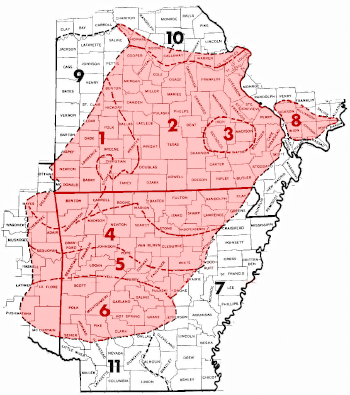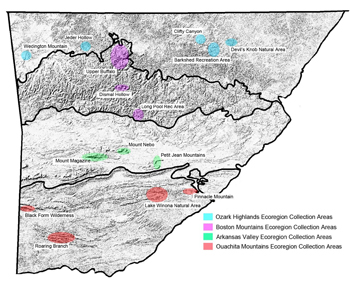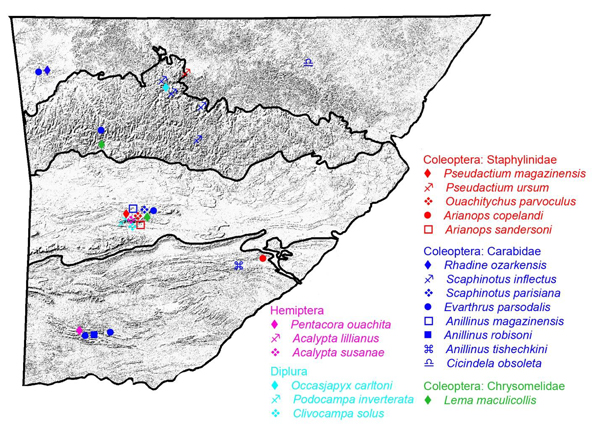

 The Interior Highlands, lying within Missouri, Arkansas, Illinois, and Oklahoma, is an extremely
understudied area of high biodiversity and potentially large number of endemic and relict species.
Suspected diversity and endemism are a result of the ancient history of the region, having been
continually habitable for approximately 320 million years (Allen 1990) and an area of refuge for all life
forms during periods of glaciation and other climatic and geological events that occurred in North
America. The biogeographic process known as the Taxon-pulse hypothesis (Erwin 1985) could have
played a major role in shaping Interior Highlands diversity as species went through numerous cycles of
seeking refuge in the Highlands and then dispersing back out as conditions became more favorable. This
repeated in and out of the Highlands could also produce numerous relict species separated from the
rest of their population by large distances.
The Interior Highlands, lying within Missouri, Arkansas, Illinois, and Oklahoma, is an extremely
understudied area of high biodiversity and potentially large number of endemic and relict species.
Suspected diversity and endemism are a result of the ancient history of the region, having been
continually habitable for approximately 320 million years (Allen 1990) and an area of refuge for all life
forms during periods of glaciation and other climatic and geological events that occurred in North
America. The biogeographic process known as the Taxon-pulse hypothesis (Erwin 1985) could have
played a major role in shaping Interior Highlands diversity as species went through numerous cycles of
seeking refuge in the Highlands and then dispersing back out as conditions became more favorable. This
repeated in and out of the Highlands could also produce numerous relict species separated from the
rest of their population by large distances.
Biodiversity and endemism in the state can also be attributed to the large number of unique habitats including various types of hardwood and pine forests, prairies, glades, expansive cypress and water tupelo swamps, higher elevation habitats and an extensive karst system. More than 200 species of endemic plants and animals are known to reside in the Interior Highlands, including approximately 70 insect endemics, however, these numbers likely only account for a small percentage of the insect diversity and endemism in the state (Allen 1990). The primary problem with establishing insect endemism in Arkansas is the lack of inventory work previously performed. In comparison to other regions in the US considered areas of high diversity and endemism (Appalachians, Pacific Northwest, Southwestern deserts), one could consider the Arkansas insect fauna poorly known. Preliminary studies over the years support the idea that the Interior Highlands and the state of Arkansas should no longer be overlooked by scientists interested in biodiversity and endemism.
 Recent funding through Arkansas State Wildlife Grants has drawn our focus to surveying habitats in Northwestern Arkansas.
Terrestrial habitats in the Ozark Highlands, Boston Mountain, Arkansas Valley, and Ouachita Mountain
ecoregions listed in the AWAP will be sampled. Specific localities within these ecoregions are chosen
based on two criteria: 1) in and around locations known to contain endemic insect taxa and 2) virgin,
well-protected, or isolated habitats with an emphasis on areas known for their unique flora and fauna.
These two criteria will allow us to establish distributions of known endemic taxa, which have often only
been collected once or just a few times, and give us the best opportunity to discover new endemic or
relict species. The study is limited to the western portion of the state within the three ecoregions listed
above to robustly sample these areas without affecting feasibility of completion. These sites have been
chosen based upon the publications describing each of the known Arkansas endemics (e.g., Robison and
Allen 1995; Robison et al. 2008) and a publication by Zachry and Berry (1979) that assessed sites
throughout the Highlands for potential preservation as natural landmarks due to the uniqueness of the
habitat or the composition of rare and relict flora and fauna. Our sampling will include sites within
various types of hardwood and pine forests, prairies, glades, cypress and water tupelo swamps and
higher elevation habitats.
Recent funding through Arkansas State Wildlife Grants has drawn our focus to surveying habitats in Northwestern Arkansas.
Terrestrial habitats in the Ozark Highlands, Boston Mountain, Arkansas Valley, and Ouachita Mountain
ecoregions listed in the AWAP will be sampled. Specific localities within these ecoregions are chosen
based on two criteria: 1) in and around locations known to contain endemic insect taxa and 2) virgin,
well-protected, or isolated habitats with an emphasis on areas known for their unique flora and fauna.
These two criteria will allow us to establish distributions of known endemic taxa, which have often only
been collected once or just a few times, and give us the best opportunity to discover new endemic or
relict species. The study is limited to the western portion of the state within the three ecoregions listed
above to robustly sample these areas without affecting feasibility of completion. These sites have been
chosen based upon the publications describing each of the known Arkansas endemics (e.g., Robison and
Allen 1995; Robison et al. 2008) and a publication by Zachry and Berry (1979) that assessed sites
throughout the Highlands for potential preservation as natural landmarks due to the uniqueness of the
habitat or the composition of rare and relict flora and fauna. Our sampling will include sites within
various types of hardwood and pine forests, prairies, glades, cypress and water tupelo swamps and
higher elevation habitats.
The primary objective is to survey four ecoregions in order to establish an inventory of
species present, with special emphasis on discovering endemic and relictual taxa. Efforts will focus on
sampling unique terrestrial habitats within these regions and areas identified in the AWAP and other
publications as hosting known endemics. For the known endemics, this project will also serve to help
establish distributions for these species. In order to make this primary objective feasible, specific
identification efforts will be limited to insect groups identified as containing Arkansas endemics by the
AWAP and groups that the PI has special knowledge of and are likely to include unique, endemic taxa
due to their ecological preferences.  The primary objective will be to identify species from terrestrial
insect groups known to contain endemics. These include Coleoptera (Carabidae and Pselaphinae with
seven and five endemic species, respectively) and Hemiptera (Tingidae and Saldidae, with two and one
endemics, respectively). We will also identify species of Diplura, since there are four known endemics in
the state and Microcoryphia because of the one known endemic from Mount Magazine. Additionally,
based on previous collections indicating potential relicts or endemics in other groups, we will identify
species within various groups of Hymenoptera and Diptera. Because of the massive number of
specimens we will deal with over the coming years, we will selectively identify from these other groups
as we find taxa that appear to be very unique to our collections.
The primary objective will be to identify species from terrestrial
insect groups known to contain endemics. These include Coleoptera (Carabidae and Pselaphinae with
seven and five endemic species, respectively) and Hemiptera (Tingidae and Saldidae, with two and one
endemics, respectively). We will also identify species of Diplura, since there are four known endemics in
the state and Microcoryphia because of the one known endemic from Mount Magazine. Additionally,
based on previous collections indicating potential relicts or endemics in other groups, we will identify
species within various groups of Hymenoptera and Diptera. Because of the massive number of
specimens we will deal with over the coming years, we will selectively identify from these other groups
as we find taxa that appear to be very unique to our collections.
We will use a combination of pitfall traps (targeting ground running insects) and malaise traps (targeting flying insects) along with hand collection and leaf litter extraction. Hand collecting will simply involve looking on and under rocks and fallen trees, on plants, and under bark for arthropods. Leaf litter will be collected from a square meter area, sifted with a litter sifter and the condensed litter residue will be placed in a gallon Ziploc bag for transport back to the lab. Litter collecting will target areas of deep rich litter, using our experience to take samples that will contain the highest diversity of arthropods. Arthropods from the litter samples will be extracted using modified Berlese funnels. Additionally, at any given time, twelve malaise traps will be running in two different ecoregions and rotated on an eight-week cycle.